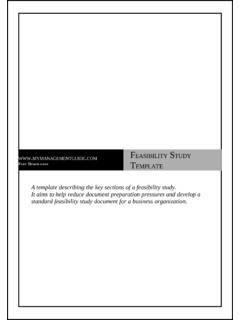Transcription of No Nonsense Technician Class - KB6NU's Ham Radio Blog
1 No Nonsense Technician ClassLicense study Guidefor tests given between July 2018 and June 2022 Dan Romanchik KB6 NUCopyright 2018 Daniel M. RomanchikAll rights reserved. No part of this publication may be reproduced, stored in a retrieval system, or transmitted in any form or by any means, electronic, mechanical, recording or otherwise, without the prior written permission of the author. Revision , 10/31/2018 Table of ContentsWhat is amateur (ham) Radio ?..1 How do you get into amateur Radio ?..1 How much does it cost?..1 Where do I take the test?..2 Can I really learn how to be an amateur Radio operator from a study guide like this?..2 How do I use this study guide ?..2 Good luck and have and terms: current, voltage, and resistance; alternating and direct current; conductors and s Law: formulas and and parallel for electronics and conversion of electrical components and circuit , capacitors and capacitance, inductors and inductance, : basic principles and applications of solid state devices, diodes and diagrams, schematic symbols, component wave , wavelength, and the electromagnetic of Radio waves and propagation and feed types and antenna lines and wave ratio and antenna Radio modes and signal modes: packet, circuits and hazards, hazardous voltages, fuses and circuit breakers, grounding, and battery and tower hazards and radiation Radio practices and station setup: connecting microphones, reducing unwanted emissions, power sources, connecting a computer, RF grounding, connecting digital controls.
2 Tuning, use of filters, squelch function, AGC, repeater offset, memory , transmitters, transceivers, modulation, transverters, low power and weak signal operation, transmit and receive transmitter and receiver problems: symptoms of overload and overdrive; distortion; causes of interference; interference and consumer electronics; part 15 devices; over-modulation; RF feedback; off frequency repair and testing: soldering; using basic test instruments; connecting a voltmeter,ammeter, or service and emergency satellite and and permissible use of the Amateur Radio Service, operator/primary station license grant; basic terms used in FCC rules; interference; RACES rules; phonetics; Frequency ; spectrum sharing; transmissions near band edges; contacting the International Space Station; power licensing: operator classes; sequential and vanity call sign systems; international communications; reciprocal operation; places where the Amateur Radio Service is regulated by the FCC; name and address on FCC license database; license term; renewal; grace and prohibited transmission: communications with other countries; music; exchange of information with other services; indecent language; compensation for use of station; retransmission of other amateur signals; codes and ciphers; sale of equipment; unidentified transmissions; one-way operator and control types: control operator required; eligibility; designation of control operator; privileges and duties; control point; local, automatic and remote control; location of control identification, repeaters, third-party communications, FCC the is amateur (ham) Radio ?
3 Amateur Radio , also known as ham Radio , is a hobby enjoyed by hundreds of thousands of Americans and millions around the world. Tey enjoy communicating with one another via two-way radios and experimenting with antennas and electronic circuits. All kinds of people are amateur Radio operators, also known as hams. Hams are young, old, men, women, boys and girls. Kids as young as seven years old have gotten amateur Radio licenses, and many hams are active into their eighties and beyond. You never know who you'll run into on the amateur Radio bands: young and old, teachers and students, engineers and scientists, doctors and nurses, mechanics and technicians, kings and entertainers. For example, did you know that most of the astronauts sent up to the International Space Station (ISS) in the last fve to ten years have been licensed Radio amateurs8 Tey use the amateur Radio station on board the ISS to communicate with school groups all over the world as they are fying over.
4 How do you get into amateur Radio ?With just a little study , you can learn all you need to know to get a Technician Class license, which is the license Class designed for beginners. To get a Technician Class license, you must take a test with 35 multiple-choice questions and answer 26 questions correctly. Te test covers basic regulations, operatingpractices, and electrical and electronics theory. Knowing Morse Code is no longer required to get this license, nor any Class of license. Technician Classlicensees have all amateur Radio privileges above 30 MHz, including the very popular 2-meter band. Technicians can also operate Morse Code (CW) on portions of the 80m, 40m, 15m, and 10m bands, and voice and digital modes on portions of the 10m band. Tere are two other license classes: the eeneral Class license and the Amateur xxtra Class license. To get a eeneral Class license, you must pass another 35-question test; the Amateur xxtra Class test has 50questions.
5 Te tests are progressively more difcult. eeneral Class licensees get phone and digital mode privileges on portions of the 160m, 80m, 60m, 40m, 20m, 17m, 15m, 12m, and 10m bands. Tey can also operate CW and digital modes on the 30mband. Amateur xxtra licensees have all amateur privileges. How much does it cost? Basic study materials, such as this study guide , can be had for free , and the license exam fee will be $15 or less. Once you have your frst license, most hams fnd it best to start with simple equipment and grow over time. A handheld VHF FM transceiver can be purchased for less than $100 new, and excellent used equipment is often available at low prices. All things considered, the cost to get the frst license and Radio should be less than $200. 1 Where do I take the test? Amateur Radio license examinations are given by Volunteer xxaminers, or Vxs. Vxs are licensed Radio amateurs who have been trained to administer amateur Radio tests. To fnd out when the Vxs in your area will be giving the test, go to the American Radio Relay League's (ARRL) website: Using that page, you will be able to search for test sessions that are close to you.
6 If you do not have access to the Internet, you can phone the ARRL at 860-594-0200. Can I really learn how to be an amateur Radio operator from a study guide like this? Yes and no. Tis manual will help you get your license, but getting your license is only the beginning. Tere is still much to learn, and to get the most out of amateur Radio , you will have to continually learnnew things. Tis study guide will teach you the answers to the test questions, but will not give you a deep understanding of electronics, Radio , or the rules and regulations. Tat will be up to you after you get your license. I hope that, by helping you get your license, this guide will encourage you to become an active Radio amateur and get on the air, participate in public service and emergency communications, join an amateur Radio club, and experiment with radios, antennas, and circuits. Tese are the activities that will really help you learn about Radio in depth, and in the end, help you be confdent in your abilities as an amateur Radio operator.
7 How do I use this study guide ? First, read through the study guide and then take some practice tests. Te characters in parentheses (T5A05), for example refer to the question number in the Technician Class xxam Question Pool. You will fnd the answers to questions in bold. You can take practice tests by going to the following websites: ( ) ( ) ( ) Tere are also ham test apps for both iOS and Android tablets: iOS: Amateur Radio xxam Prep ( prep-2technician/id2979514968mt=8). $ Ham Radio xxam ( tech/id6019919358mt=8). FRxx. Android: Ham Radio study ( ) Ham Test Prep ( ) Many of the questions use acronyms with which you may be unfamiliar. In the glossary, you will fnd defnitions of those acronyms. Please refer to the glossary if you are unsure of the meaning of an acronym. Good luck and have fun I hope that you fnd this study guide useful and that you ll become a Radio amateur. Remember that getting your license is just a start and that you will continue to learn new things.
8 If you have any comments, questions, compliments or complaints, I want to hear from you. x-mail me at My goal is to continually refne and improve this study Romanchik KB6NU 3 Electrical principlesUnits and terms: current, voltage, and resistance; alternating and direct current; conductors and insulatorsFigure 1 shows a simple electric circuit. It consists of a voltage source (in this case a battery, labeled x), a resistor (labeled R), and some wires to connect the battery to the resistor. When connected in this way, the battery will cause a current (labeled I) to fow through the 1. A simple electric circuitTe three basic parameters of this circuit are electromotive force (x), current (I), and resistance (R). xlectromotive force, or xMF, is the force that causes electrons to fow in a circuit. We use the letter x to denote electromotive force. xlectromotive force is measured in volts, and we use the letter V to denote : What is the electrical term for the electromotive force (xMF) that causes electron fow8 (T5A05)ANSWxR: VoltageQUxSTION: What is the unit of electromotive force8 (T5A11)ANSWxR: The veolt vQUxSTION: How much voltage does a mobile transceiver typically require8 (T5A06)ANSWxR: About v12 veoltsCurrent is the fow of electrons in a circuit.
9 In Figure 1, the letter I stands for current. Current fows from the positive (+) terminal of the voltage source through the circuit to the negative terminal of the voltage source. Current is measured in amperes, and we use the letter A to stand for : What is the name for the fow of electrons in an electric circuit8 (T5A03)ANSWxR: CurrentQUxSTION: xlectrical current is measured in which of the following units8 (T5A01)ANSWxR: Amperes Because the polarity of the battery voltage never changes, the current will fow in only one direction through the circuit. We call this direct current, or DC. QUxSTION: What is the name for a current that fows only in one direction8 (T5A04)ANSWxR: Direct vcurrentBatteries supply direct current, or simply, is the third parameter. As the name implies, resistance opposes the fow of electrons in a circuit. Te higher the resistance, the smaller the current. We use the letter R to stand for resistance. Resistance is measured in ohms, and we use the ereek letter omega ( ) to stand for ohms.
10 Te type of current you get out of a wall socket is diferent from the current that you get from a the battery, the polarity of the voltage changes from positive to negative and back to positive on a regular basis. In fact, it changes polarity 120 times per second. Tis means that the current changes direction 120 times per second. Because of this, we call it alternating current, or : What is the name for a current that reverses direction on a regular basis8 (T5A09)ANSWxR: Alternating vcurrentOne of the most important parameters of an alternating current is its frequency. Te frequency of an alternating current is the number of cycles per second, where a cycle is the time required for an alternating current to go from 0 V to its most positive value, then negative to its most negative value, then positive to 0 V : What term describes the number of times per second that an alternating current makes a complete cycle8 (T5A12)ANSWxR: FrequencyQUxSTION: What is the unit of frequency8 (T5C05)ANSWxR: Hertz1 Hz is equal to one cycle per second.







